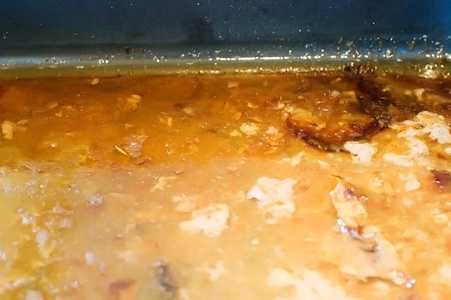- 1 bag of turkey organs Drippings and fat from roasting turkey
- 1 can low sodium chicken broth
- 5 or 6 tablespoons of flour Black pepper
- Remember the freaky little bags of organs we pulled out of the turkey? We need to rinse them, then put them in a small saucepan. Cover them with water, then bring to a boil and cook for about fifteen minutes, or until cooked thoroughly.
- After they’re cooked, turn off the heat and set aside.
- After you take the turkey out of the roasting pan, this is what’s left. In terms of Thanksgiving flavor, folks, this is Fort Knox. Pour all the drippings into a separate container. Let it sit there and separate for awhile. Once the fat has separated from the drippings, skim it off the top… And put it in a separate bowl.
- Now, set the roasting pan on the stove (I use two burners) and turn it on low heat. Put 3 or 4 tablespoons of the fat back into the roasting pan.
- Sprinkle 5 or 6 tablespoons of flour into the pan. With a whisk stir the flour into the fat, scraping up all the bits from the bottom of the pan as you go. Keep stirring until combined. You want it to be pasty (more floury than greasy), but still stirrable. If you add too much flour and it gets cakey and dry, just add in another tablespoon of fat.
- Cook the roux (fat/flour combo) over low heat until the color of the brown deepens, about 4 or 5 minutes.
- Now, get 1 can of LOW SODIUM chicken broth and pour it into the pan, whisking as you go. Work quickly to get all the roux mixed in with the liquid.
- Now add in about 1 cup or so of the turkey drippings (not the fat-the drippings.) and whisk it in and stir as the gravy thoroughly warms and thickens.
- At this point, if you’d like the gravy to be less “speckly” or “dirty” in appearance, you can skim a small strainer along the top. That’ll clean it up a bit. Or, you can just leave it and rest assured it’ll taste just perfect.
- This stage of the gravy is very important; it has to cook for several minutes (even more) in order to thicken and reach the desired consistency. This is a very organic process and not difficult at all if you have a few tricks up your sleeve.
- If the gravy gets too thick too soon, you can always thin it a bit with a little giblet water. It’s flavorful without being salty. If the gravy cooks and cooks but remains too thin just mix 2 or 3 tablespoons of flour with enough water to make it stirrable, and stir it in. Slowly, the gravy will begin to thicken.
- You can also continue to add more turkey drippings if you think the gravy needs a little more depth of flavor.
- And don’t forget the black pepper-add as much as you want! Just do NOT add salt indiscriminantly without tasting first.
- Now, we talked about what to do if your gravy becomes too thick while it’s cooking. But what
- Now, when the gravy’s close to being perfect, chop up the giblets you boiled earlier and add them into the gravy. I like to use the gizzards, when are the grayish/brown organs. The liver is the reddish/pink organ. The giblets have a delightful-but strong-flavor, so if you’re not sure, just taste as you go.
- You can add as much or as little as you want; it’s a personal preference.
